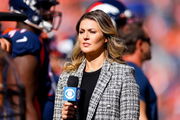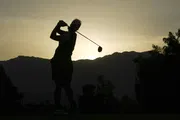

The US Open is all set for its triumphant return in the coming week at the Los Angeles Country Club (L.A.C.C). Los Angeles, also known as the ?City of Angels,? hosted the last US Open in 1948 and the last major in 1995. Both of these tournaments were organized at Riviera Country Club. But this time there is a new venue in town, and it is creating all the buzz.
Watch What’s Trending Now!
LA Country Club has staged the Los Angeles Open five times, but not since 1940. The course is ready to host the world?s best golfers for the highly coveted title after the North Course?s restoration in 2010. Let us take a look at the course guide for the 2023 US Open venue.
Top Stories
Another PGA Tour Analyst to Leave Golf Channel Days After Cara Banks’ Unexpected Exit – Report

‘Sorry for Your Loss’: Phil Mickelson Sends Prayers as Golf Reporter Opens Up About Daughter’s Passing

Concerns Arise as Amanda Balionis Says She’s Exhausted After Demanding Golf Schedule

LPGA Legend’s Son, 14, Shows No Remorse After Beating His Mom at Golf

Tiger Woods’ GF Receives Emotional Message from Daughter Kai Trump After Turning 48

ADVERTISEMENT
The ultimate hole-by-hole guide to the North Course at L.A.C.C
The hole-wise guide for the most talked-about venue for the 2023 season is as follows:
1st, 590 yards, par five
The first hole on the course offers a perfect opportunity for the golfers to hit a birdie. The only thing to keep in mind is to stay away from the bunkers that are present on either side of the fairway landing zone.
ADVERTISEMENT
Read More: Amid The Latest Billion Dollar Merger, Is Dustin Johnson Playing in the 2023 U.S. Open?
2nd, 497 yards, par four
ADVERTISEMENT
After the easy first hole, the second hole is referred to as a punch in the nose. The first par-4 on the course features a fairway that slopes from right to left and a green protected by a dry gully that traverses the front nine.
3rd, 419 yards, par four
The second par-4 of the course has a barranca on the left side of the fairway. This hole offers both features: a blind tee shot and an approach. This hole has three large palm trees surrounding it, and the slope is from back to front.
ADVERTISEMENT

Imago
A flag with the US Open logo is on the grounds at the 122nd United States Open Championship at The Country Club in Brookline, MA on Wednesday June 15, 2022. PUBLICATIONxINxGERxSUIxAUTxHUNxONLY BOP20220615112 JohnxAngelillo
4th, 228 yards, par three
This downhill par-3 hole is a dramatic one. Due to the green’s location, approximately 30 feet below the different tees, the distance the ball travels when played may be shorter. While the barranca in front of the green should not be a concern, there are bunkers positioned on the right and left that are ready to catch any wayward shots.
ADVERTISEMENT
5th, 480 yards, par four
The main target of the players on the 5th hole is to find the left side of the generous fairway. The opposite sides slope towards the rough. A pair of bunkers guard the right side of the spacious green, but shots can be guided toward it through an opening on the left.
6th, 330 yards, par four
ADVERTISEMENT
The par-sixth hole presents a challenging dogleg to the right, potentially offering an opportunity for players to drive toward the green with a powerful blind shot. The green itself is situated on a shelf behind a sweeping hillside, adding to the difficulty. There are two greenside bunkers and a barranca surrounding the green that is to be kept in mind. Even choosing the safer option of laying up on the left side for better positioning does not guarantee an easy birdie. Due to the narrowness of the tabletop green, precise wedge shots are essential to successfully navigate this hole.
7th, 284 yards, par three
This hole is the third-longest par-3 hole in the history of the US Open. The barranca gracefully makes its way towards the green, forming spacious landing areas resembling fairways on both sides. Eventually, the barranca emerges to form a bunker that hugs the right edge of the putting surface. Opting for shots that land a bit short and then bounce forward might be the wise approach to the game.
ADVERTISEMENT

Imago
credits: Imago
8th, 537 yards, par five
This is again a very tricky par-5 for the golfers. But it also offers a good chance of birdie to the golfer, but the point to note is that the landing area of this hole steeps from left to right, towards the trees and deep dry area. If the drive reaches the level portion of the fairway, it sets up a partially obscured shot toward a compact green.
ADVERTISEMENT
9th, 171 yards, par three
This narrow green is 43 yards long and is flanked by three large bunkers in the front. On this uphill par-3 hole, just the perfect shots will be intact. If a player ends up hitting a poor shot, they will surely be taking a long walk on the bridge over the barranca.
10th, 409 yards, par four
The trio of bunkers that guide the right side of the fairway will cause a problem for the golfer. The bunkers should be avoided. Steeping from right to left, the tee shot must avoid a large bunker complex.
11th, 290 yards, par three
This 11th hole is the second-longest par 3 in US Open history. Two good things about this hole are the spectacular LA skyline views and the fact that it’s 20 yards shorter than the yardage. The 290-yard par-3 still requires a long carry to clear the three bunkers in front of the green.
12th, 380 yards, par four
The 12th hole is probably the most difficult hole on the course. It does not have any fairway bunkers, but two frontline bunkers stand fortressing the access to a severe green of ridges and slopes. The golfer tees up a blind shot into the course?s narrowest fairway.
13th, 507 yards, par four
The 13th fairway might be the widest fairway in the history of the US Open. There are two bunkers on each side of the fairway. On the right side, if any shots are blocked off, they will roll into a deep swale, leaving golfers with a blind view of their next shot. In case the bad luck continues, the golfers might find themselves in yet another bunker or entangled within the hedges that mark the property boundary adjacent to the Playboy Mansion.
14th, 623 yards, par five
The last par five on the course is also the longest hole on the historic venue of the 2023 US Open. The landing area is tightly squeezed by a cluster of three bunkers, compelling players to aim towards the left for safer play. The next challenge arises with a blind second shot, as the hole runs parallel to the property boundary, accompanied by four concealed bunkers that line up along the right side. If the shot veers too far right, it will result in a downhill descent into a treacherous area filled with trees and potential difficulties. The oddly shaped putting surface is guarded by three greenside bunkers strategically placed to protect various pin positions, which add a lot more complexity.

USA Today via Reuters
Jun 19, 2022; Brookline, Massachusetts, USA; Matthew Fitzpatrick lines up his putt on the sixth green during the final round of the U.S. Open golf tournament. Mandatory Credit: Peter Casey-USA TODAY Sports
15th, 124 yards, par three
Just as the end approaches, the holes get even more difficult at L.A.C.C. This oddly shaped green is surrounded by three bunkers all around and has a lengthy teeing ground. It is hard on this hole to not end up in one of the bunkers. This par 3 is the shortest yet trickiest one in tournament history.
16th, 542 yards, par four
The 16th hole marks the beginning of the three consecutive par fours to finish. It is one of the longest par fours in US Open history. The tee shot at this 542-yard hole is steeply downhill to a smooth fairway that is surrounded by a bunker on the left side.
17th, 520 yards, par four
The 17th par-4 is surrounded by a barranca on its right, but still, the golfer gets the fair opportunity of hitting the shot into a well-bunkered green. There are five bunkers strategically positioned to catch any ineffective shots aimed at reaching the diagonal green, resulting in challenging recovery shots under the intense pressure of a major championship. The hazards begin approximately 50 yards before the center of the putting surface.
18th, 492 yards, par four
The hole sitting in front of the clubhouse steeps upwards and into the prevailing breeze. The right side of the fairway of the finishing hole offers the best angle for the golfer to approach a deep green. At this hole, the final walk is either of a champion or a walk of disappointment, knowing that a golfer has failed to emerge as the ultimate champion.
The US Open is a historic tournament with a lot of amazing and unheard facts. Are you excited to see who will emerge victorious at this iconic golf course? What are your thoughts about this one-of-a-kind golf course? Let us know in the comments below.
Watch This Story:?Brooks Koepka gets a response from a PGA official for his Ryder Cup saga
ADVERTISEMENT
ADVERTISEMENT
ADVERTISEMENT

